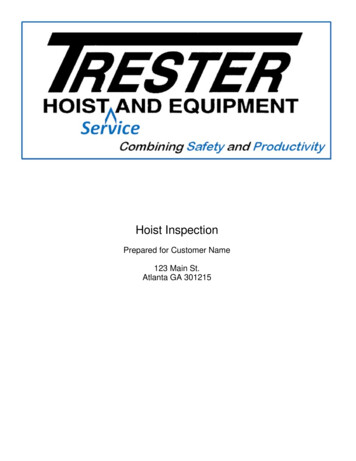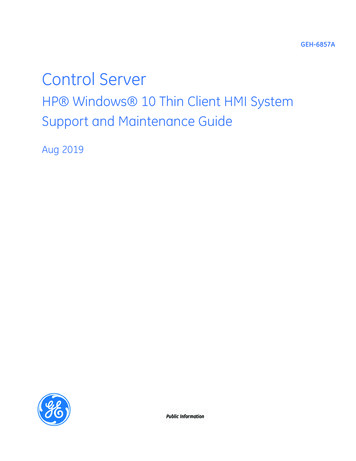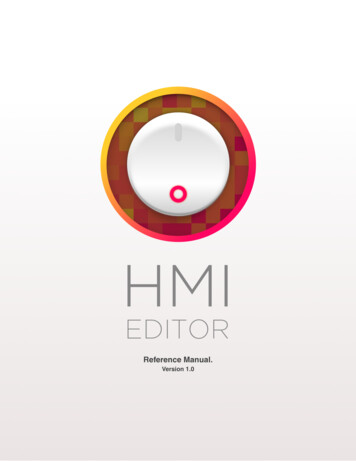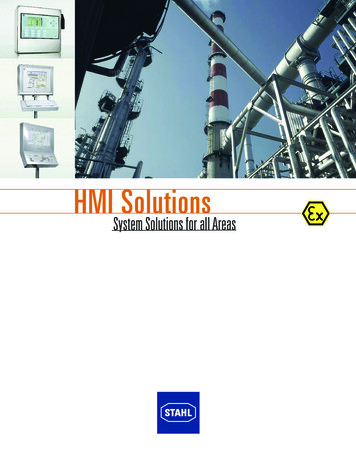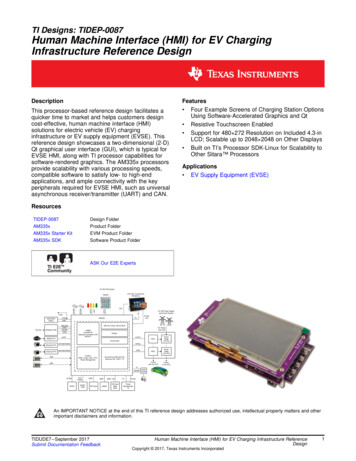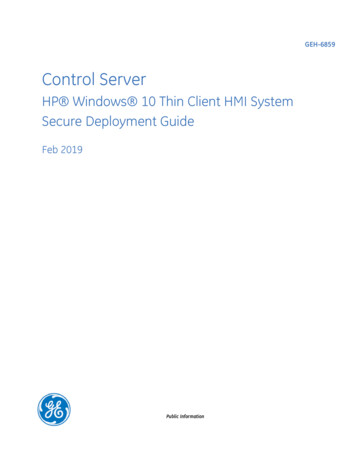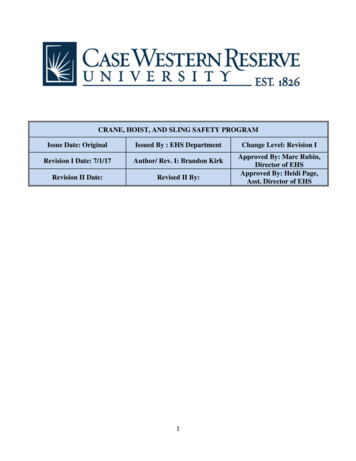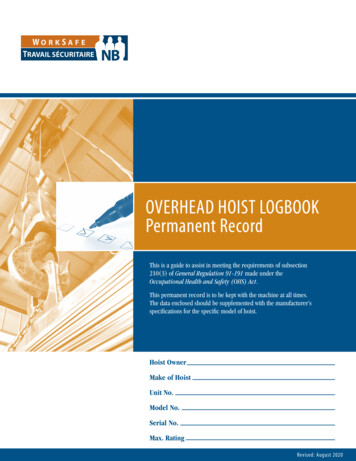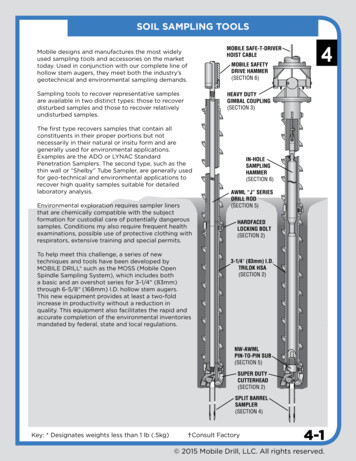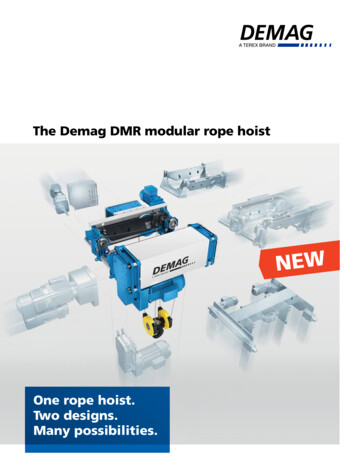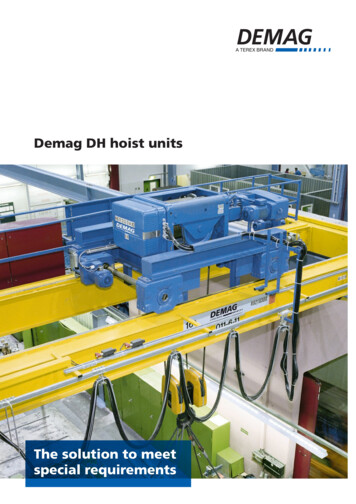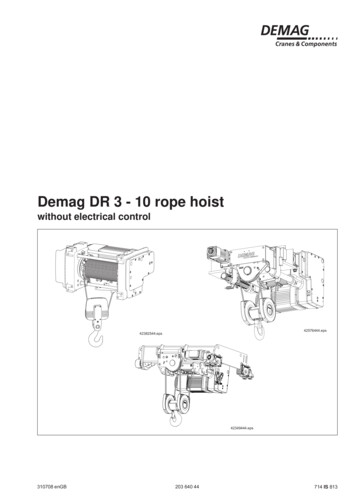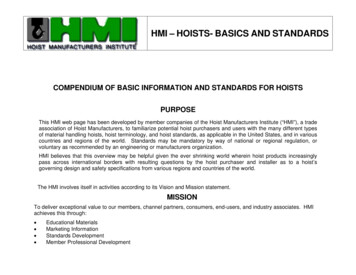
Transcription
HMI – HOISTS- BASICS AND STANDARDSCOMPENDIUM OF BASIC INFORMATION AND STANDARDS FOR HOISTSPURPOSEThis HMI web page has been developed by member companies of the Hoist Manufacturers Institute (“HMI”), a tradeassociation of Hoist Manufacturers, to familiarize potential hoist purchasers and users with the many different typesof material handling hoists, hoist terminology, and hoist standards, as applicable in the United States, and in variouscountries and regions of the world. Standards may be mandatory by way of national or regional regulation, orvoluntary as recommended by an engineering or manufacturers organization.HMI believes that this overview may be helpful given the ever shrinking world wherein hoist products increasinglypass across international borders with resulting questions by the hoist purchaser and installer as to a hoist’sgoverning design and safety specifications from various regions and countries of the world.The HMI involves itself in activities according to its Vision and Mission statement.MISSIONTo deliver exceptional value to our members, channel partners, consumers, end-users, and industry associates. HMIachieves this through: Educational MaterialsMarketing InformationStandards DevelopmentMember Professional Development
VISIONHMI is recognized as the leading authority and the principal resource in the hoist industry.HMI is recognized as the leading advocate for the safe application and operation of hoisting equipment and relatedproducts.HMI conducts business professionally with a spirit of enthusiasm, cooperation, honesty and integrity.HMI’s members are recognized as: The leaders in the marketplaceDelivering superior value in their products and servicesProviding products and services that are safe and productiveProviding high value solutions through knowledgeable and expert channel partnersProviding an environment in which our customers can confidently purchase and derive superior value from ourproductsDISCLAIMERThis Standards Overview for Overhead Hoists (“Overview”) is advisory only and hasbeen promulgated by the Hoist Manufacturers Institute (“HMI”) with the sole intent ofoffering information for interested parties. HMI makes no warranties whatsoever inconnection with this Comparison. HMI specifically disclaims all implied warranties ofmerchantability or of fitness for a particular purpose. Further HMI, its officers, agentsand employees shall not be liable in tort, contract or otherwise – whether based onwarranty, negligence, strict liability or any other theory of liability for any action orfailure to act in connection with this Overview and this information, it being the user’sintent and understanding to absolve and protect HMI, its successors and assigns,officers, agents and employees, from any and all liability in tort, contract or otherliabilityHoist Manufacturers Institute8720 Red Oak Boulevard, Suite 201Charlotte, NC 28217 – 3992www.mhia.orgPhone: 800-345-1815, 704- 676-1190Fax:704-676-1199
Hoist BasicsSome basic information about hoists is presented here. More in-depth information is available in the various manuals published by HMI[http://www.mhiastore.org/category.cfm?Category 40]AN OVERHEAD HOIST IS A MACHINE USED FOR VERTICAL LIFTING OF MATERIAL (NOT PEOPLE) THAT IS FREELYSUSPENDED (UNGUIDED).A MANUALLY LEVER OPERATED HOIST IS A DEVICE USED TO LIFT, LOWER, OR PULL A LOAD (NOT PEOPLE), AND TO APPLYOR RELEASE TENSION TO ITEMS.Hoists can provide lifting and lowering motions in an overheadmaterial handling system. When a hoist is mounted to a trolleyon a fixed monorail, two directions of load motion are available:forward or reverse, up or down. When the hoist is mounted on acrane, three directions of load motion are available: right or left,forward or reverse, up or down. These systems can achievestraight-line moves, reduce material damage, reduce noise,minimize energy cost, reduce floor-based traffic, improve workerergonomics, and accomplish other operational objectives.Usually, a hoist is not a piece of stationary hardware. It isgenerally available for use whenever required and rarely requiresa full time operator. Hoists can be integrated into a variety ofautomated handling systems.In an overhead material handling system, hoists provide verticalmovement of below-the-hook load supporting and positioningdevices.In any material handling system, the hoist is used to accuratelyposition a load.The majority of hoists used in the United States are classified asStandard or “packaged hoists”, typically defined as largely selfcontained units, prepared to be installed on existing structures.They are selected and installed into an application, often as partof a system. These systems vary greatly from simple, manuallycontrolled systems to complex integrated and automated systemsinvolving sophisticated components and controls. Hoists can bepowered manually, with air, hydraulics, or electricity. Trolleyselection is dictated by system requirements.This publication does not specifically address “Built-up Hoists”,which may be covered by other standards, more crane related.Types of Overhead HoistsThese hoists are defined by: Mounting Type – There are eight suspension/mounting methods for overhead hoists: Hook Mounted, Clevis Mounted, Lug Mounted,Trolley Mounted, Deck Mounted, Base Mounted, Wall Mounted, and Ceiling Mounted. Lifting Medium – Four types of lifting medium for overhead hoists: Welded Link Chain, Roller Load Chain, and Wire Rope, syntheticweb or rope material. Power Application – Three methods of applying power for overhead hoists: Manually by Hand Chain, Electric Power, and Air Power.
Overhead Hoist Mounting TypesHoist mounting selection depends upon the requirements of the application and must be considered in conjunction with other Trolley Types:BaseCeilingPlainHand Chain GearedMotor Driven
Overhead Hoist Lifting MediaWelded Link Chain (Roller Load Chain notshown)Wire Rope
Overhead Hoist Power ApplicationManual, by Hand ChainElectricPneumaticSupply Equipment OptionsElectric is the most commonpower sourcePneumatic power is oftenrequired in applications of highspeed, higher duty cycleinvolving rapid, repetitive tasksor hazardous areas whereelectric power is inadvisable.Power supply and control cords,cord reels, hoses, electrificationsystems, and flexible festooningsystems provide means forsupplying power to hoists. Suchsystems must be properly sizedand meet all prevailing codes orregulationsControl OptionsA wide range of pendant andremote controls are available toprovide suitable and convenientpositioning for the operator.Operational ConsiderationsHoist operators should be trained in the proper use of all hoistingequipment. Many accidents occur because operators simply donot know that they are doing something dangerous. Refer to themanufacturer’s parts, maintenance and operating documents.ASME B30.16 deals with equipment and the workplace safetyissues, which apply to all overhead hoists that lift freelysuspended unguided loads.
Lifting ConsiderationsTo select the proper hoist, consider:A.The weight of the load to be lifted including below-the-hook lifting, load supporting, andpositioning devices.B.Physical size of the load.1.Holding and orienting devices.2.Design for center of gravity (control & stability).C.Lift – the vertical distance the load can be moved.D.Clearance Considerations.1.Headroom2.Obstacles to be cleared during the load transfer.3.Design for vertical lift required including holding device height.E.Lifting Speed Considerations.1.Distance the load is to be raised and lowered2.Frequency of usage3.Required positioning accuracy4.Nature of the load being liftedF.Hoist duty Cycle Considerations based on:1.Number of lifts per hour2.Total number of lifts per shift3.Maximum number of starts and stops per hour4.Number of shifts per day5.Average distance load is raised and lowered6.Average weight to be lifted7.Maximum weight to be lifted8.Frequency of lifts with maximum weight.
Types of Manually Lever Operated HoistsThese manually lever operated hoists are defined byfour types of lifting media: Roller Load Chain Welded Link Chain Wire Rope Web Strap.
BalancersThese overhead devices provide and perform functionsdifferent from overhead hoist in that they can lift, lower andfloat a load. The balancer configurations and suspensionsare similar to a hoist.The balancer functions differently from a hoist.Thefunctional difference is indicated in the name: balancer. Abalancer balances the load in a near weightless conditionduring the lifting operation. This feature allows the operatorto maneuver the load easily.Balancers are often used for awkward and / or rapid loadmovements. Balancers can also be used to suspendequipment, which is used in repetitive operation.A variety of control options are available.A very broad range of load handling devices (end effectors)can expand this product’s versatility.Balancers are typically supported on small jibs, lightmonorail systems, or enclosed track monorail systems.Equipment CharacteristicsVertical lift onlyMax. Lifting Capacity: 500 pounds, approx.Weigh:100 pounds, approx.Balancers may or may not have been historically designed with hoist standards applied. Work is presently under way by the ASME B30committee to prepare a safety standard for balancers. When available this standard will be released at B30.28
Hoist StandardsThere are many standards produced by many different standards-writing bodies. In an ever-shrinking world, hoist productsincreasingly pass across international borders. The list of standards referenced below is by no means complete, yet, in HMI’sopinion, represents the standards that are applicable in different regions of the world. Since some of those standards maydiffer from the country to country, it is important for purchasers, installers, and users to know which ones apply for a particularsituation.USAIn the USA, the American Society of Mechanical Engineers (ASME; website www.asme.org) publishes standards for hoists.Three are safety standards and six are performance standards. All carry the American National Standards Institute (ANSI)designator for a consensus American National Standard rformance Standard for Electric Chain HoistsPerformance Standard for Hand Chain Manually Operated Chain HoistsPerformance Standard for Manually Lever Operated Chain HoistsPerformance Standard for Overhead Electric Wire Rope HoistsPerformance Standard for Air Chain HoistsPerformance Standard for Air Wire Rope HoistsSafety Standard for Base Mounted Drum HoistsSafety Standard for Overhead Hoists (Underhung)Safety Standard Manually Lever-Operated HoistsOSHA (Parts 1910 and 1926) adopts or invokes the American Society of Mechanical Engineers (ASME) HST Performance andB30 Safety Standards for hoists and related equipment.Generally, for hoist installations in the US the standards published by the American Society of Mechanical Engineers apply.
INTERNATIONALNON-EUROPEANOutside North America, ISO (International Organization for Standardization) is sometimes referenced. For certain areas of the Asianmarkets the Japanese JIS standards may apply. Following is a selection of ISO and JIS standards applicable to hoists directly or throughassociation with lifting machinery such as cranes:ISO STANDARDSThe International Organization for Standardization (ISO; website www.iso.ch) publishes many standards for numerous types of liftingmachinery, many specifically for application, design, operation and maintenance of cranes. Below is a brief selection applicable to hoistsand hoist components:ISO 1837ISO 2374ISO 2408Lifting Hooks - NomenclatureLifting Appliances - Range Of Maximum Capabilities for Basic ModelsSteel Wire Rope for General PurposesJIS STANDARDSThe Japanese Industrial Standards Committee (JIS; website www.jisc.go.jp) publishes standards for hoists. Some of the primary ones are:JIS B 8802JIS B 8815JIS B 8819JIS C 9620Manually Operated Chain HoistsElectric Chain HoistsManually Operated Chain Lever HoistsElectric Wire Rope HoistsEUROPEANTraditionally, European countries have maintained nationalstandards in reference to a large number of industrial products, e.g.DIN (Germany), BSI (United Kingdom). In addition the FEM(Federation Europeenne de la Manutention) has publishedstandards specifically for material handling and lifting equipment.There are three main regulations: Machinery Regulation (including Lifting and Material HandlingEquipment) Low Voltage Electricity Regulation EMV – Electro-magnetic Compatibility RegulationWith the creation of the European Union, organizations forstandardization were established at different levels of regulatoryauthority covering numerous product areas.At the next level are CEN (mechanical) and CENELEC (electrical)Standards. They are more detailed and product oriented than theregulations. Per definition, the publications of CEN and CENELECare “Standards”, non-regulatory guidelines, reflecting state of the artdesign and construction practices. They are based on the highestlevel of probability that equipment, designed to these standards willbe safe and functional. They do not preclude deviations or “productimprovement based on technological progress”.The highest regulatory level is a European Standards Commission.Its regulations are absolute and regulatory, focusing primarily onworker safety and protection from occupational hazards.
The goal of the CEN & CENELEC Committees is to harmonize thenew, European norms with existing country-specific norms. Thecommittees responsible for generating new standards includeworkgroups and sub-committees, which are comprised ofrepresentatives of related industries, academia and engineeringresearch, as well as legal counsel. When a new CEN/CENELECstandard is introduced and “HARMONIZED” (language, legal, etc.
ASME-B30.21 Safety Standard Manually Lever-Operated Hoists OSHA (Parts 1910 and 1926) adopts or invokes the American Society of Mechanical Engineers (ASME) HST Performance and B30 Safety Standards for hoists and related equipment. Generally, for hoist installations in the US the standards published by the American Society of Mechanical Engineers apply. INTERNATIONAL NON
